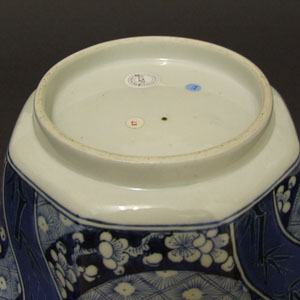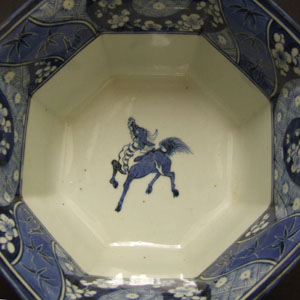
ARITA c.1770 – 1790 Japanese Porcelain
An 18th Century Blue and White Japanese Porcelain Bowl, Arita Kilns c.1770-1790. Decorated Using the White Porcelain as Well as Sumihajiki to Depict Gnarled Prunus within Textile Inspired Designs. The Well Painted with Kirin (In Chinese Qilin or Kylin).
SOLD
- Condition
- Perfect.
- Size
- Diameter : 20.9 cm (8 inches). Height : 11 cm (4 1/3 inches).
- Provenance
- N/A
- Stock number
- 22981
Information
Qilin or Kylin :
A Qilin (Kylin) is a mythical hooved Chinese chimerical creature. Despite its fierce demeanour it is a good omen that brings Rui (roughly translated as `serenity` or `prosperity`), longevity, illustrious offspring and wise administration. The scaly body has a dragons head, hooves and can appear to have fire issuing from its body. The male Qilin is called a Qi and the female a Lin. The male often has horns. These creatures carefully tread to avoid all living insects or destroy grass under foot, it is reputed to be able to walk on water as well as land. Qilin only appear to mankind when an emperor of the highest benevolence sits on the throne or when a sage is about to be born. There is a strong argument that the Qilin is a stylised representation of the giraffe. This is because the Qilin is referred to only since the Ming Dynasty. The time of its first reference correspond roughly with the voyages of Zheng He, there were seven voyages between 1405 and 1433 (Zheng He lived c.1371–1435). It is known that on Zheng He`s voyage to East Africa (landing, among other places, in modern-day Kenya), the fleet brought back two giraffes to Beijing. It is also known that these two giraffes were referred to as Qilins. The Emperor proclaimed the giraffes magical creatures, whose capture signalled the greatness of his power.
Sumihajiki :
This type of ceramic decoration appears in Japan just after the middle of the 17th century, although its origins are much earlier. The effect created is that of painted white lines cutting through blue, this is achieved using a wax resist type paint called `sumi` which protects the white porcelain from the cobalt blue over-painting. The `sumi` is burnt off during the firing to leaving white lines to contrast against the blue.
